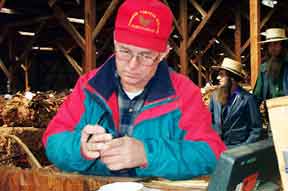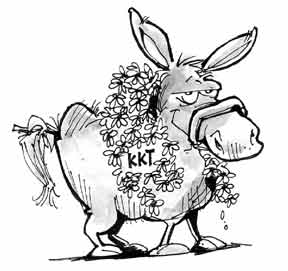|
|
 |
|
photo by Russ Barnes
|
Maryland Tobacco Is Going, Going … Gone
As market master Raymond Guy tallies up this day’s sales of Maryland’s finest type 32 tobacco at auction in Hughesville, tobacco farmer Betty Russell speaks a common concern: “Today, grade number one sold for only about $1.80 per pound,” she says. “That’s just not enough to make farming tobacco worth it. But then we hear that the buyout might not even have enough money to pay farmers who do sign.”
The buyout Russell speaks of is an arrangement to help farmers stop growing tobacco. If they forego planting tobacco and agree to keep their land in agriculture for at least 10 years, farm owners are guaranteed income for a decade. Payments, set at $1 per pound, are figured on the farmer’s average crop in the years 1996 through 1998. The payments are the farmers’ cut of the multibillion-dollar fund supported by cigarette companies to settle their liabilities for health damages. Seventy-eight percent of Maryland tobacco farmers have signed up for the buyout.
Signed up, but not with easy minds: Will the buyout really stick? Will the promise of payment be made good? Those questions worry farmers inside and outside the warehouses where the centuries-old ritual of tobacco auctions are staged each year during March. This year’s auctions began March 19 at the state’s five tobacco warehouses. In the short auction season, less than four million pounds of tobacco will be traded, a sharp drop in sales over 2001.
But as cigarette sales drop, so do tobacco revenues. Because the state settlements are tied to a percentage of company income, the companies may not be able to afford paying the projected amounts. In case projected tobacco company settlements falter, Maryland has a backup plan.
The House of Delegates has approved a $30-million bond issue to cover any shortfall. The bond money will be drawn down as needed over 10 years.
“Maryland is dedicated to farmers,” says Hagner Mister, Maryland’s secretary of agriculture.
"Our promise is good to farmers who quit growing tobacco and try alternative crops.”
 |
|
photo by Russ Barnes
A declining tobacco crop combined with dropping auction prices leaves less money to count for tobacco farmers and others like Hughesville Tobacco Auction market master Raymond Guy, above.
|
Overseeing the buyout and the future of former tobacco crop land is Christine Bergmark of the Tri-County Council for Southern Maryland. Tobacco settlement money — or, when needed, Maryland state bond money — is transferred from the state agriculture department to Tri-County Council which, contrary to the “three” implied in its name, administers payments to five Maryland counties. Of the 728 Southern Maryland farmers who have signed the buyout’s dotted line, 70 are from Anne Arundel County; the rest farm in the Southern Maryland counties of Calvert, Charles, Prince George’s and Saint Mary’s.
There are incentives for trying alternative crops, but tobacco was bred into these farmers’ bones. Some have family ties to tobacco going back four centuries.
Tobacco farming taps deep into the Maryland soil as well. “There’s a special combination of nitrogen and lime in the soil here that’s good for this kind of tobacco,” says Silvia Butler, who owns the Wayson-Butler farm on Jewel Road at the Anne Arundel-Calvert County line. “They’ve tried to take these plants to Pennsylvania, to Kentucky — but they won’t grow any place else.”
The special value of Maryland tobacco is understood by bidders at the Hughesville tobacco auction. Many have come to the warehouses in Hughesville and Waysons Corner from as far away as Italy, Argentina and Australia to pay homage to slow-burning Maryland tobacco.
Those buyers may be getting a good deal this year, according to several farmers who wistfully remark on low selling prices.
Bringing new crops to the unique nitrogen- and lime-rich soil of Southern Maryland will take some innovative thinking and patient experimentation. But there are groups to help.
To encourage new crops, Anne Arundel County Executive Janet Owens has convened her own Agricultural Development Advisory Committee. It will explore innovative marketing, alternative crops, and productive training and farm labor. A citizens’ Alternative Crops Committee of Anne Arundel County collaborates on coming up with new crops. Across the five tobacco-growing counties, the Tri-County Council is drafting a plan for a market and a restaurant to showcase Southern Maryland agriculture and crafts.
“Right now, Southern Maryland is unlike any other place,” says Mister. “So much land has been converted from tobacco that it’s a great time to look to other crops.”
Southern Maryland, according to Bergmark, has advantages other than just good soil and climate: “Our close proximity to the metropolitan areas of Washington and Baltimore provides many agricultural market venues such as farm visits and bed and breakfast attractions.”
There’s no slam-dunk solution to choosing an alternative crop approaching, if not equal to, tobacco. Finding a new crop as dependable as tobacco will take time, innovation and experimentation. Meanwhile, the buyout helps farmers finance a period of uncertainty as they search for that new crop to replace one that’s going, going … gone.
— Russ Barnes with Francis R. Gouin, Professor Emeritus, University of Maryland.
The Political Scene ~ Donkeys in Clover
 |
|
illustration by Jim Hunt
|
Anne Arundel County’s Democrats celebrated their party’s tradition at their annual Jefferson-Jackson Day reception like donkeys in clover. Homestead Gardens, where they gathered, was in full spring bloom. And if the March night was chilly, the partisans were crowded together so closely in the party tent that they shared one another’s warmth.
The field was theirs alone — Republican Congressman Bob Ehrlich had still to enter the race for governor — and if budgets were tight, crime and infant mortality were both down. Making those claims, the jubilant Kathleen Kennedy Townsend — a favorite with the blood lines of champions — looked like she was already in the winner’s circle, sporting a victory horseshoe of black-eyed Susans.
But if there is a downside to clover, it is that each donkey in rich fodder does its own thing. The feasting Democrats were loath to put aside their conversations and plates of roast beef to return to the toil of pulling their party to victory.
Party leaders called the donkeys to order to little avail. It took the bass bellow of Senate President Mike Miller — the chief donkey at a gathering absent of both the governor, Parris Glendening, and the county executive, Janet Owens (though oddly not her likely challenger, former Delegate Phillip Bissett, a Republican) — to clear the way for the lieutenant governor.
Sensing the crowd’s mood, she made her case in a staccato burst, then mingled with her stablemates.
Even that seasoned troubadour of labor and liberal causes Joe Glazer couldn’t pull the party from personal politicking and talk of those amazing Terps, scheduled to play that very night at 10pm. Though he and his wife had blazed up from Florida for the event, he halved his planned offering of political songs.
“There are two kinds of events,” Glazer reflected, packing up his guitar with its unsung songs.
"At this kind, you say what you’ve got to say quickly like the lieutenant governor did and be done with it. The people are taking their energy from one another.”
But in one of his two songs, the wise old rallier laid out the road to November to an audience not quite ready to listen. Praising the evening’s honoree Bill Waldecker, a party loyalist who’d never run for public office, Glazer likened him to a character from the activist, early 20th-century novels of Upton Sinclair — one who labored backstage for the cause, not the clover.
— SOM
 |
| Mike Patterson and Colleen Sabo with Ladyhawk on release day. |
Rehabilitated Hawk Flies over Rose Haven
She came to us injured and young by way of West Virginia, where a veterinarian needed a home for a wounded hawk. Three months later Ladyhawk hunts the fields of Rose Haven, in Southern Anne Arundel County.
The six-month-old red-tailed hawk — the largest local hawk species — began her journey to recovery at Watkins Nature Center in Upper Marlboro. Like the hawk, the Center was recuperating. A falling tree caused so much damage to the building that it had to be rebuilt. After more than two years of reconstruction, the Center reopened in July. Among the new exhibits was a bird-of-prey complex. There, Ladyhawk joined 11 disabled birds — owls, falcons and vultures — as creature-teachers for visiting school programs.
Ladyhawk’s rehabilitation was swifter than that of the nature center. X-rays showed a bullet lodged in one of her flight muscles. The prognosis was good. With care, food and rehabilitation, she could be released.
Naturalists Jackie Carson, Mike Patterson and Colleen Sabo worked daily with the bird, flying her on a long cord to build her strength. Many other raptor-loving volunteers stopped to watch her progress.
But to survive in the wild, she would have to be able to fly, catch live food on her own and seek shelter. She was only about six months old when she was injured, as we could tell from her juvenile striped tail and her light eye color. Adult red-tails have dark brown feathers, dark eyes and a beautiful auburn tail.
To teach the newly fledged bird how to feed herself, catching live mice, we had to make sure she could catch mice on her own. We began by presenting her six to 10 dead mice on a log perch each day. After she put on some weight and started flying, the mouse pool was introduced. A live mouse was put in an empty plastic baby pool in her cage. At first, the mice escaped. Then, one afternoon, we saw Ladyhawk with the mouse in her beak. With that breakthrough, we knew we could soon release her back into the wild.
On March 1, Ladyhawk was ready for the wild. The big, red-tailed hawk, was released at Rose Haven, as its open space gives her fields to hunt. As Ladyhawk flew off into the trees across the field on a beautiful sunny day, we wished her well.
Learn more? Watkins Nature Center: 301/218-6702.
Postscript: Colleen Sabo and Lisa Garrett have seen the hawk since her release. She is recognizable as a large hawk with a silver anklet.
— Lisa Garrett, Watkins Nature Center
Winner Feasts, Loser Fasts ~ Hoyer Hopes for BBQ Jayhawk Ribs
There’s more at stake in the Final Four than basketball.
There are victory spoils on the table.
Two powerful alums of two of the contenders — Maryland Congressman Steny Hoyer and Kansas Congressman Dennis Moore — have staked a good dinner on their schools.
If the Terrapins prevail, Hoyer will dine on two pounds of Kansas City ribs. But if they fall, he’ll have to pay up two pounds of Maryland crabs.
Knowing one or the other will soon have to put his money where his mouth is, each is talking tough.
“The Jayhawks are going to feast on the Maryland Terrapins on Saturday,” boasted Moore, a 1967 University of Kansas alum. “And I can’t wait to feast on some fine Maryland crab, courtesy of my good friend Steny.”
Hoyer, a 1963 graduate of the University of Maryland, rose to that challenge. “I want to congratulate the Jayhawks, who’ve been flying high all year long,” he said. “But the Terps are going to bring them down to earth when they clip their wings on Saturday.
“So, I want to assure my good friend, Dennis, that while I’m feasting on those delicious Kansas City ribs, I’ll order him up a slice of humble pie. Dennis should have remembered that old fable of the hare and the tortoise. You should always fear the turtle.”
Should the Terps fail and Hoyer be talking trash, he’ll also be talking postponement. This year’s Maryland crab season doesn’t open until April 1, with the first crabs typically not reaching market for a week or 10 days. Maybe a U.S. congressman can speed up the harvest. Otherwise — heaven forbid — he may be tempted to pay off in the counterfeit currency of Confederate crabs.
Even if crabs materialize, Moore will need a second course. Two pounds of crabs amounts to only six or eight crustaceans, depending on size. But if the Jayhawks win, Marylanders will be eating up all the humble pie.
— Bay Weekly
Way Downstream …
In Virginia, the Chesapeake Bay Foundation is succeeding influence-wise — so well that the director of the state office for the non-profit advocacy group, Joseph Maroon, was named last week by Gov. Mark Warner to head the Virginia Department of Conservation and Recreation …
In Atlanta, Home Depot reports a flood of calls to its headquarters from consumers trying to beat the drought. A company spokesman said that water restrictions in the Northeast are triggering sales of low-flow shower heads and new toilets that use about one-third less water when flushed …
 Our Creature Feature comes from Australia, where not even python dung will drive away the giant bats of Sydney. Thousands of flying fox bats — weight nine pounds with a three-foot wing-span — have gathered at the Royal Botanic Gardens after being driven from the wilds by development. Our Creature Feature comes from Australia, where not even python dung will drive away the giant bats of Sydney. Thousands of flying fox bats — weight nine pounds with a three-foot wing-span — have gathered at the Royal Botanic Gardens after being driven from the wilds by development.
Bats and gardens might sound like a good mix, but the weight of the upside-down hanging bats is damaging 200-year-old trees. Groundskeepers tried spreading red-hot paste from chili peppers on the limbs, and then the python waste. Now they’re trying to scare away the bats with loudspeakers broadcasting two hours of shrieks and bangs beginning each day at dawn.
Copyright 2002
Bay Weekly
|